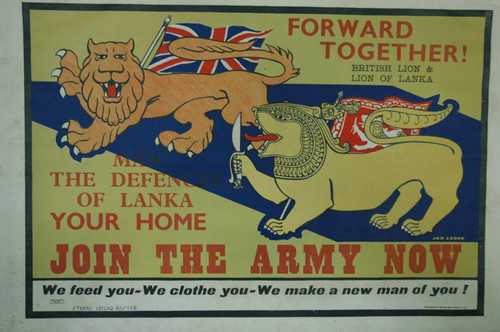
Posters Artwork Documents
Two Lions go to war ...
National Archive of Sri Lanka.
As was the case with many British Crown Colonies, Britain did not attempt to introduce conscription to the Crown forces in Sri Lanka. However, as was equally common, significant efforts were made to recruit the locals to those forces. This poster, featuring the British Lion and the Lion of King Vjaya, was part of this recruitment effort. The Lion of Sri Lanka is an extremely ancient symbol of royal power on the island, having been introduced by the first King of Sri Lanka and his followers, immigrants from what is now Indian Bengal. It was subsequently used by successor dynasties and claimant-dynasties of the various (often warring) Sri Lankan kingdoms until (after about ten years of messy colonial wars and rebellions), Great Britain finally extinguished the rule of the Sri Lankan kings and nobles by about 1820. Its use here is striking, for two reasons. First, while not exactly suppressed, the Lion symbol was not afforded any official status in the British Crown Colony, who used an Elephant as their emblem and featured an elephant, along with a Buddhist stupa and the Union Jack, on their colonial flag. Its reappearance here in an official context, after so long, represents a significant departure. Secondly, the use of the Lion here is part of a direct appeal to Sri Lankan patriotism, coming at a time when the British were sitting on an increasingly explosive cauldron of Sinhalese/Sri Lankan nationalism fuelled by what had been, from the outset, the rather oppressive form of colonial rule exercised by the British. Another aspect of the use of the Lion was that its appeal would have been strongest among the Sinhalese traditionalist elements of the population traditionally "favoured" (relatively speaking) by the British. There may have been an implicit acceptance here that recruitment was likely to be most successful in the Sinhalese community. Britain's recruitment effort in Ceylon was reasonably successful. Many members of the local "army" (the Ceylon Defence Force, a British-commanded force) as well as civilians from the general population, did volunteer, and served in the British forces in both front-line and support units in Burma and North Africa in particular. However, its success was limited by increasing resentment on the part of many among the (British educated) Sinhalese élite at the oppressive, exclusionary (and indeed) racist administration of the country, which prompted some of the opposition and leftist leaders (who had not, as many had, been detained by the colonial government) to engage in treasonable contacts with anti-British Indian nationalists and with the Japanese, aimed at obtaining assistance in the overthrow of British rule on the island. Nothing came of these efforts. However, in the end, British rule outlasted the Second World War by only a few years. Best regards, JR.
2021 Views
8/21/2007
